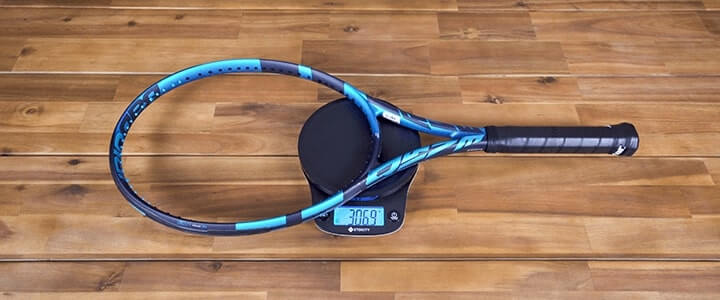Check out my custom vibration dampener
Custom Tennis Racquets
A Guide to Personalize Your Frame
If you’re a serious player, you may be looking to customize your tennis racquet to enhance your performance.
These days, the vast majority of professional players on tour play with customized racquets. By adjusting the weight, balance, and similar characteristics of their racquets, they’re able to complement their game to match their style of play. It’s also common for players to enjoy making cosmetic changes to their racquet to show a flare of their personality even under strict dress codes.
Even if you only play tennis casually, you can still benefit by making a few tweaks to your racquet, and you don’t need to spend hundreds of dollars to get your racquet customized. You can easily customize any of the top tennis racquets with a few simple tools like lead tape and cotton balls.
Article Contents
Click below to jump to a section
Tap below to jump to a section
Who Should Customize?
Why Customize?
Customizing for Performance
Customizing Aesthetics
How to Customize
Where Can You Customize?
New to TennisCompanion?
Create a free account and explore my latest videos below
Who Should Customize Their Racquet?
If you’re an absolute beginner, racquet customization will likely be overkill because it will be difficult to detect the nuances in performance. Instead, we’d recommend focussing your energy on developing proper technique and a feel for the game before considering any serious customization. Here are a few affordable racquet options for you to check out.
On the other hand, if you’re an intermediate to advanced player, you may find that you benefit from making a few small tweaks to your racquet. Of course, if you’re considering customizing your racquet, you likely have a sense of what you might want to change.
Why Customize Your Tennis Racquet?
There are two reasons why you might want a personalized tennis racquet:
- Performance
- Aesthetics
Performance
As we already touched on, customized tennis racquets allow you to tweak the specs of the racquet to optimize your play on the court. Some frequent changes players make include:
- Changing the overall racquet weight
- Moving their racquet’s balance point
- Adjusting the swingweight
- Increasing their racquets stability
Each of these may simply be a player’s preference in that the racquet feels better for them. However, these changes can have a direct impact on a player’s control, power, or ability to execute various shots.
Once they find the specs that work for them, players will match or adjust all of their racquets to the same weight and balance. If you have to switch racquets during a match, you don’t want to notice a difference in the balance or weight.
Even if you’re playing with two identical stock racquets, there may be slight deviations in these specs. As your level of play improves, a variance of a few grams might be the difference between making and missing a shot during a big match.
To this end, the vast majority of professional players customize their racquets to ensure the highest level of consistency. Some players, such as Federer, pay tens of thousands of dollars a year to have their racquets strung and customized by the same person.
Aesthetics
The second reason you might want to customize your racquet is to let more of your personality shine through. Some tennis clubs have relatively strict dress codes, such as requiring that everyone on their courts wear white. Changing the appearance of your racquet gives you some room for personal expression without violating the rules.
Customizing for Performance
The most common changes that players make are to the weight, balance, and swingweight of their racquets. Let’s look at how changing these specs on your racquet can affect your game.
Racquet Weight

As we already mentioned, even racquets of the same model can have slight variations in their weight. If you want to match the weight of all your racquets, the easiest way is by adding weight to your lightest racquet to match your heaviest.
Increasing your racquet’s weight can add power or stability to your swing and can reduce vibration when you hit the ball. However, a heavier racquet also means that you may get fatigued faster and your racquet will be harder to maneuver. Generally, heavier racquets are better suited to experienced players who have the strength and technique to use them.
When you adjust the weight of your racquet, you need to do so strategically to avoid unintentionally changing the balance of the racquet. Any changes to the balance you make should be deliberate. Remember, every time you add weight to your racquet, you’re going to shift the balance to that side of the racquet (unless you add additional weight to counterbalance).
Check out our guide on racquet weight and balance if you want to learn more about how these two specs change impact performance.
Racquet Balance Point

The balance point is the center of mass for your racquet. It’s the point of the racquet where if you rested it on your finger, it would lie flat without falling. Many players prefer keeping the balance point closer to the handle to make the racquet head-light and more maneuverable.
Racquets with their balance point higher on the head of the racquet are generally lighter overall. If you make changes to the overall weight of your racquet, you need to apply it evenly across the racquet unless you want to shift the center of mass.
It’s common for players to add weight with lead tape to the 10 and 2 o’clock positions of their racquets for additional stability. Essentially, the extra weight helps keep your racquet from twisting once you make contact with the ball. It also raises the sweet spot so you’ll get a cleaner shot when you hit the ball near the top of your racquet’s head.
Adding weight to your racquet a little lower at the 3 and 9 o’clock positions can add even more stability and widen the size of the sweet spot.
Racquet Swingweight
Swingweight is the inertia that the racquet generates as you swing it. If most of the weight of the racquet is near the head, the racquet will produce more momentum, and you’ll be able to deliver more power with your shot. However, the trade-off is you sacrifice maneuverability.
You can manipulate swingweight by changing the balance point and overall weight of the racquet. For instance, if you add lead tape to the inner rim of your racquet, you’re increasing the weight of the head and subsequently shifting the balance point away from the handle. If you add lead tape under your grip, it does the opposite.
Customizing for Aesthetics
If you want to customize your racquet without changing the way the racquet plays, you can give your tennis racquet a custom paint job or change the grip.
Custom Manufacturer Paint

Some racquet brands like Wilson and Head allow you to choose custom colors when you order a new racquet.
In the online Wilson Custom Racquet Shop, you can choose from 23 colors for the frame, top of the racquet’s hoop, and 3 and 9 o’clock decals. Additionally, Wilson also allows you to customize the color of the grommets, logos, grip, and last but not least, add a personal inscription within the racquet’s throat.
Custom Paint On Your Own
While not our recommended approach for customizing the aesthetics of your racquet, you can also spray paint them. Here are a few reasons we’d advise against it:
- It’s a labor-intensive process
- You will likely unintentionally change the specs of the racquet and be stuck with inconsistent performance if you have multiple racquets to paint
- You’ll void the racquet’s warranty if it has one
Of course, if you consider these factors, it’s still a viable method for personalizing your tennis racquet. It can also serve as a fun art project if you’re looking to customize a tennis racquet for decoration.
Here are some high-level steps to get you started:
- Remove grommets, strings, any stickers, and grip
- Strip the racquet’s paint using a paint stripper
- Sand the frame to remove any remaining paint and for improved application of the primer
- Thoroughly clean and wipe down the frame and let dry
- Apply 2-3 coats of primer
- Use tape to mask off your desired area for paint
- Apply a few coats of paint and let dry
- If desired, apply a seal coat for protection
Changing Your Grip
Another part of your racquet you can easily customize is your grip. You can use a custom replacement grip to change the overall balance of your racquet (more on this later), or you can change the color.
Again, keep in mind that changing the grip may shift the balance of your racquet, so it’s a good idea to weigh your racquet before and after.
How to Customize Your Own Tennis Racquet
There are many companies out there that will customize your racquet for you. However, it’s relatively easy to cheaply experiment with modifying your racquet at home with a few simple tools.
If you plan to make changes to your racquet, you’ll need a small scale that can weigh your racquet to a tenth of a gram. You can use a postal scale or some food scales to achieve this level of accuracy.
You’ll also need a balance board to monitor changes in the balance of your racquet before and after modifications.
A few other things you may want to have handy include:
- Double-sided taping to reapply the adhesive backing to the grip
- Scissors
- Cotton balls
- Awl
- Ruler
- Lead or tungsten tape
- Tungsten putty
A Note on Lead & Tungsten Tape
Lead or the now more commonly used tungsten tape allows you to easily add small amounts of weight to your racquet to change the balance. Tape comes in either ½ inch or ¼ inch widths. Generally, 4 inches of ¼ inch width tape is equal to about a gram, but be sure to check the details of the tape you’re using.
These days, tungsten tape is one of the most common tools players use to change the specs on their racquets.
Customize Your Racquet’s Weight
If you want to customize your racquet weight without changing the balance of your racquet, you’ll have to add an even amount of weight on either side of the balance point.
You can add weight to the head of your racquet by adhering lead tape to the inner edge of your racquet’s frame or you can add lead tape under your grip to shift the balance away from the head of your racquet.
Alternatively, you can add lead tape to the bottom of the frame near the throat. Since this area is close to the balance point, the additional weight won’t change the overall racquet balance significantly.
Making Your Racquet More Head-Light
If you want to adjust your racquet so that it’s more head-light, you can add weight to the handle of your racquet. Most racquets have a removable butt cap on the end. Once you pop the cap off, you’ll see a space at the end of the handle where you can add cotton balls. You can add tungsten putty to the cotton before resealing the cap.
Not all racquets will allow you to access the inside of the handle via the butt cap. If that’s the case, one option is to purchase tennis racquets with a smaller grip size and then bring the racquet’s grip size back up to your preference using a heat shrink sleeve. These handy sleeves are available in full size or half size and will add weight to the handle while allowing you to maintain your preferred grip size.
If you have already purchased a tennis racquet or can’t afford to buy new ones, another reasonable way to the weight in your racquet’s handle is by replacing your synthetic grip with a leather one. Since leather is heavier, this can add some additional weight. Of course, the exact amount depending on the type of leather.
Making Your Racquet More Head-Heavy
If you want to add more weight to the head of your racquet to increase swing weight, the easiest way to accomplish this is by adding lead tape to the inner edge of your racquet’s head.
Keep in mind that it’s always easier to add weight to your racquet than take it away. If you know you’re going to want to change the balance, make sure you account for the additional weight you’ll add when buying a racquet.
Where can I get my racquet customized?
These days, tennis brands are starting to offer more options for custom tennis racquets.
The two brands that offer the most customization directly from their websites are Wilson and Head. Here’s a breakdown of what you can change when you order directly from their websites.
Wilson
On Wilson’s website, they allow you to choose one of their popular models like Federer’s Pro Staff RF97 Autograph and change the color of the frame, finish, grip size, and add a custom inscription. As of today, they’re focused on aesthetics only, so if you want to change the specs of your racquet you’ll have to do it yourself or find someone to help you.
Head
If you order a Head custom racquet from their website, you can change everything from the racquet length, weight, balance, frame color, and grip shape. Their online shop essentially gives you the ability to design a racquet from scratch as the pros do.
Babolat & Yonex
If you want a custom Babolat or Yonex racquet, you can buy them from a third-party seller who can change the balance and weight for you. Many local shops will be able to help guide you or make changes to your racquet for you.
Online Retailers
Top online retailers offer racquet pairing serves to find you two tennis racquets of the same model that are as close to a perfect match as possible. They’ll also offer services to precisely match racquets. Both services are reasonably priced and worth considering if you demand a certain level of consistency in your tennis racquets.
Master Racquet Technicians
For the best result, we recommend looking for a Master Racquet Technician (MRT) who’s certified and trained to customize the specs of your tennis racquet. They can work with any model and make virtually any customization to meet your needs.
Wrapping Up
No matter who you are, you can likely appreciate the benefits of a custom tennis racquet. When you personalize your racquet to match your skill level and style, you allow yourself to maximize your potential. And besides, it can be a fun process tinkering with your racquet.
You may have to experiment with different specs until you find the combination most suited to you, but that’s typical, and as your game evolves, you may see yourself making additional changes.
If you’re an absolute beginner, you’re going to benefit dramatically more from developing your game than changing the specs on your racquet.
However, with that said, there are still plenty of great racquets to choose from that don’t require customization. Check out our articles on the best racquets for beginners if you’re looking for something you can start playing with right away.
Both Wilson and Head offer a custom racquet shop on their websites that allow you to changes to your racquet before you even buy it. If you want to make further changes to your racquet, you can experiment with changing the weight, balance, or swingweight by adding lead tape to different parts of your racquet.
What changes have you made to your racquet? Leave a comment and let us know!
Play Better Tennis
Improve your game alongside our community of tennis players
Why join?
Discussion Boards
Join the conversation with other members of the community.
5 Point Friday
Read our weekly recap of the 5 most interesting things we dig up in tennis.



Leave a Reply
Want to join the discussion?Feel free to contribute!